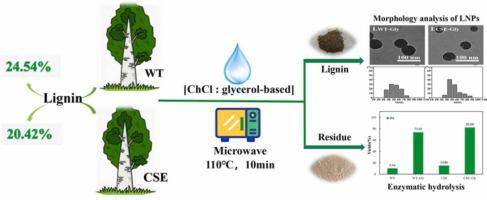Industrial Crops and Products ( IF 5.9 ) Pub Date : 2021-12-06 , DOI: 10.1016/j.indcrop.2021.114275 Ling-Hua Xu 1 , Cheng-Ye Ma 1 , Chen Zhang 1 , Jing Liu 1 , Xiao-Peng Peng 2 , Shuang-Quan Yao 3 , Dou-Yong Min 3 , Tong-Qi Yuan 1 , Jia-Long Wen 1

|
Genetic engineering is considered a promising approach to decrease “biomass recalcitrance” and enhance the lignin valorization. Caffeoyl Shikimate Esterase (CSE) was recently indicated to play an important role in lignin biosynthesis. However, the effect of this enzyme on poplar lignin structure and subsequent treatment has not been systematically analyzed. In this study, ultrafast microwave-assisted deep eutectic solvents (DES) pretreatment was effectively performed to deconstruct the main components in wild-type (WT) and CSE down-regulated poplar. After pretreatment with two kinds of DES (ethylene glycol-based and glycerol-based DES), the saccharification efficiency of CSE down-regulated poplar was significantly improved, reaching 96.15%. In addition, the yield of DES lignin increased to 62.66% and 72.89% after Ethylene Glycol and Glycerol-based DES pretreatment in CSE poplar woods as compared to WT poplar wood (48.06% and 60.47%). Moreover, structural and morphological variations of lignin after CSE down-regulation and DES pretreatments have been systematically studied by 2D-HSQC, 31P NMR, GPC, SEM, and TEM techniques. Results showed that native lignin from WT and CSE down-regulated poplars had similar structural features excepted for high content of H-type and p-hydroxybenzoate (PB) units in the CSE down-regulated poplar lignin. Furthermore, quantification of different linkages (β-O-4, β-β, β-5, etc.) in native lignin and DES lignin fractions suggested the ultrafast DES fractionation resulted in the significant cleavage of these linkages under glycerol-based DES pretreatment. Meanwhile, the DES lignin from glycerol-based DES pretreatment was found to be small and homogeneous lignin nanoparticles (LNPs). In short, the glycerol-based DES pretreatment is an environmentally benign scheme to produce easily digestible biomass and the LNPs with narrow size distribution. These findings are very important in assessing the fabricability of CSE poplar in the current biorefinery scenario.
中文翻译:

通过微波辅助低共熔溶剂 (DES) 对野生型和 CSE 下调的杨树进行超快速分馏,以增强纤维素生物转化和木质素纳米颗粒的制造
基因工程被认为是减少“生物质抵抗”和提高木质素价值的一种有前途的方法。最近表明咖啡酰莽草酸酯酶 (CSE) 在木质素生物合成中发挥重要作用。然而,这种酶对杨树木质素结构和后续处理的影响尚未系统分析。在这项研究中,有效地进行了超快微波辅助深共晶溶剂 (DES)预处理以解构野生型 (WT) 和 CSE 下调杨树的主要成分。用两种DES(乙二醇基和甘油基DES)预处理后,CSE下调的杨树糖化效率显着提高,达到96.15%。此外,与WT杨木(48.06%和60.47%)相比,CSE杨木中基于乙二醇和甘油的DES预处理后DES木质素的产率分别增加到62.66%和72.89%。此外,已通过 2D-HSQC、31 P NMR、GPC、SEM 和 TEM 技术系统地研究了 CSE 下调和 DES 预处理后木质素的结构和形态变化。结果表明,来自 WT 和 CSE 下调的杨树的天然木质素具有相似的结构特征,除了CSE 下调的杨树木质素中 H 型和对羟基苯甲酸 (PB) 单元的含量高。此外,量化不同的联系(β- O-4、β-β、β-5 等)在天然木质素和 DES 木质素馏分中表明超快 DES 分馏导致在基于甘油的 DES 预处理下这些键的显着裂解。同时,发现来自基于甘油的 DES 预处理的 DES 木质素是小而均匀的木质素纳米粒子 (LNP)。简而言之,基于甘油的 DES 预处理是一种环境友好的方案,可生产易于消化的生物质和尺寸分布窄的 LNP。这些发现对于评估 CSE 杨树在当前生物精炼方案中的可加工性非常重要。


























 京公网安备 11010802027423号
京公网安备 11010802027423号